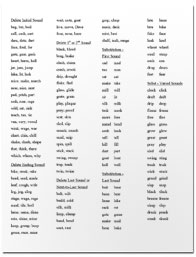
In the OnTrack Reading Phonics Program, four tests are given at the outset of instruction. Three are purely auditory and the fourth is Code Knowlege. The auditory tests are:
- Blending Ability
- Segmenting Ability
- Phonemic Awareness
The test in the phonics section titled Testing Auditory Processing Skill covers just one aspect of phonemic awareness: the ability to delete a sound from a word. If a child misses items on that test, he definitely needs more oral practice deleting, adding, and manipulating (changing) phonemes within words. In the course of the program, the exercises described below are given to all students, until they are proficient at all the levels.
However, if your child still finds these oral exercises too difficult, you should first work on phonemic awareness skill by using letter tiles to help make the required linkage between sounds and symbols. Those exercises are described in Auditory Processing with Tiles.
Before you begin the exercises described here, download the PDF file below. It’s a list of words divided into seven categories. Incidentally, a similar list can be found on the last page of the OnTrack Reading Advanced Code Phonics Workbook which, together with its comprehensive instruction manual, comprises a complete science-based advanced code phonics program covering phonics skills, code knowledge, and a well-tested multisyllable decoding method you will find nowhere else.

First, notice that each list is organized so that almost all of the consonant sounds are manipulated, with two or three examples of each. For example, the first row of words all start with the /b/ sound, the second start with the /k/ sound, etc. If you notice that your child has trouble deleting one particular sound, make sure and use the other examples on that row at some point.
Category 1: Delete Initial Sound
To start this exercise, ask your child to remove the first sound from each word. Ask him to say the word, then after he repeats the word, ask him to say it without the target sound. Here is exactly what to say, using beg for an example:
You: “Say beg.”
Child: “Beg.”
You: “Now say beg without the /b/.”
*Remember, /b/ means the sound of b, not the letter name.
Notice that each modified word still sounds like a real word. This offers your child a clue that they’re on the right track. The exercise also emphasizes auditory skills. Since the spoken word often differs from its spelling (like "eg" versus "egg"), your child can’t easily rely on visual cues. They'll have to focus on the sound, which is the goal.
Start with this category – it's usually the easiest. Test multiple words to identify any initial sounds that are difficult for your child to drop. Once you've covered this ground, proceed to Category 2.
Category 2: Delete Ending Sound
Following the same procedure as Category 1, ask your child to say the full word first, then ask him to say it without the last sound in the word. The first row of words all end in the /b/ sound, the second in the /k/ sound, and so on. Again pay attention to any difficulties your child may have in omitting specific sounds. If so, spend extra time practicing those.
Once your child becomes proficient with the Category 2 list, it’s time to challenge them. Intermingle words from Categories 1 and 2. Ask them to eliminate the first sound for one word and the last sound for the next. When they’re comfortable switching between beginning and ending sounds, advance to Category 3.
Category 3: Delete First or Second Sound
Think of this category as having two subcategories, 3a and 3b. Each row targets a different initial blend permitted in English words. In each case, your child can omit either the first or second sound to produce a recognizable word, although the spelling may differ. For instance, removing the /p/ from plaque results in lack. This is a valuable exercise because it pushes your child to rely more on auditory skills.
Notice the clues: if your child easily handles words that maintain spelling consistency, like black to lack, but struggles with those that require spelling changes, like plaque to lack, it indicates a reliance on visual cues. This shows you where additional practice is needed.
Start by asking your child to only remove the first sound in the blend. This is usually easier but can be a challenge if your child is used to treating blends as a single unit. Once mastered, reverse the task: ask them to omit the second sound, which is generally more difficult (“Say black without the /l/”).
Finally, once your child can easily remove both the first and second sounds, mix things up. Alternate between requesting the removal of first and second sounds to increase their auditory awareness. When they’re proficient in this, it's time to advance to Category 4.
Category 4: Delete Last or Next-to-Last Sound
Again, this is really two subcategories 4a and 4b. 4a involves deleting the last sound, as this is usually the easier task. This list is shorter than the others because there are a limited number of ending consonant blends in English words. Repeat the process described for Category 3, working on 4a, then 4b, then mixing it up. Then start mixing up requests from all four categories and subcategories. When your child can handle anything you ask of him in this regard, move on to Category 5.
Category 5: Substitution-First Sound
Now we are finally getting to the ultimate goal of this: to train your child to easily switch from one sound to another in a spoken word. Why is this important? Because for your child to easily test different vowel sound options in an unfamiliar word, they must develop a facility for quickly switching sounds orally without having to reblend the word sound by sound.
With this list, tell your child to “Say sad, but change the /s/ to /m/.” The first word serves as your starting point, while the second specifies the new sound to introduce. Remember that /s/ and /m/ refer to sounds, not letter names. After your child can easily switch initial sounds, move to the next category.
Category 6: Substitution-Last Sound
Do the same process as the previous category. Then start randomly mixing your requests between Category 5 and Category 6 words. After your child can easily do that, move to the Category 7 list.
Category 7: Substitution-Varied Sounds
Here you’ll use the first word as a starting point and then use the second word to figure out what to tell your child to do. For example the first row is clock-click. This means that you should ask your child to say clock but change /o/ to /i/.
Once your child can easily do all seven categories, their ability to manipulate phonemes should be reasonably well developed. This skill is trainable, and OnTrack Reading clients almost always became capable of doing all seven categories.
If you only have minor concerns about your child's phoneme manipulation skills, you can streamline the process. Focus on their proficiency with words from Categories 3a/3b and 4a/4b. Then, jump to Category 7 and choose a word featuring a changing vowel sound, like the sled-slid example. Select a sequence of vowel changes that all result in real words, such as sled-slid-slide-slowed, and guide your child through the series. If they can navigate this progression successfully, it's a strong indicator of their ability to adapt vowel sounds in unfamiliar words –achieving the ultimate goal of these exercises.




